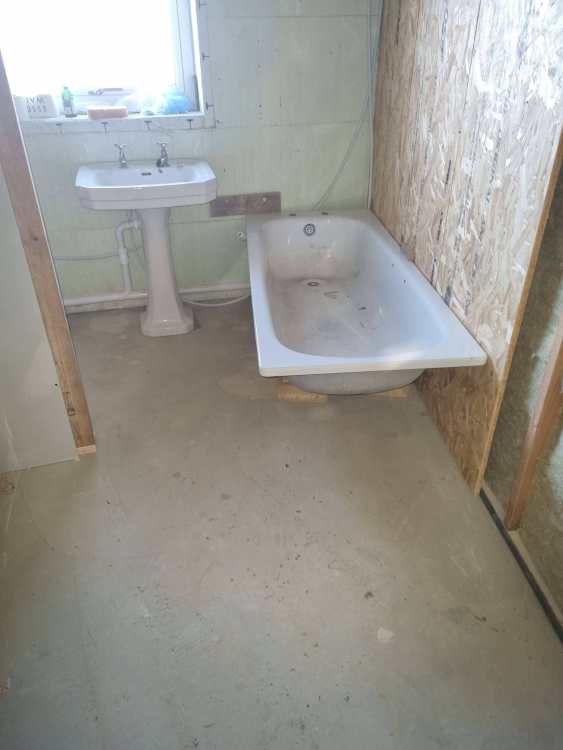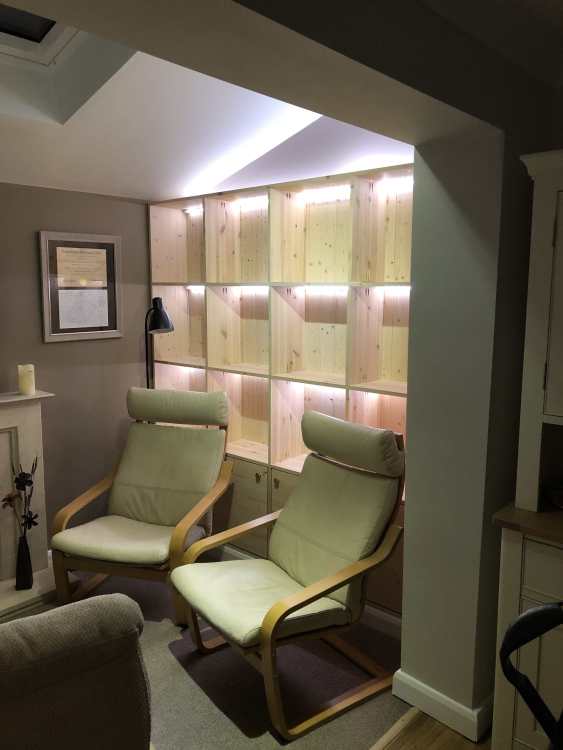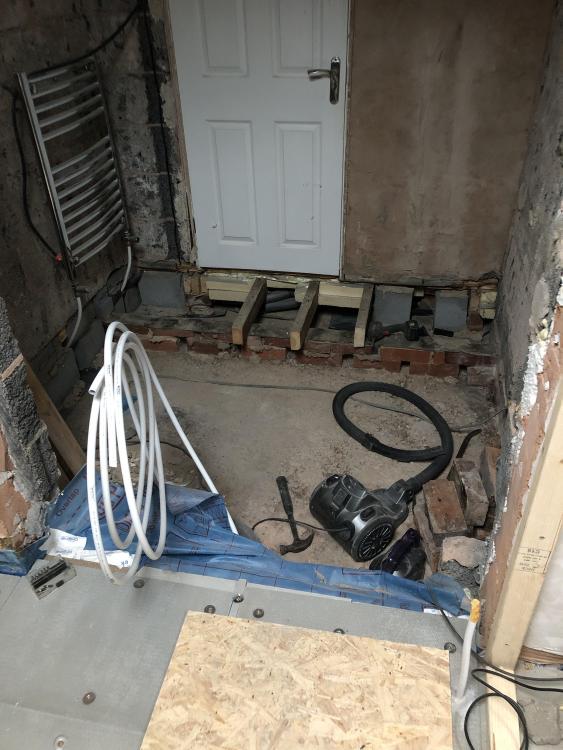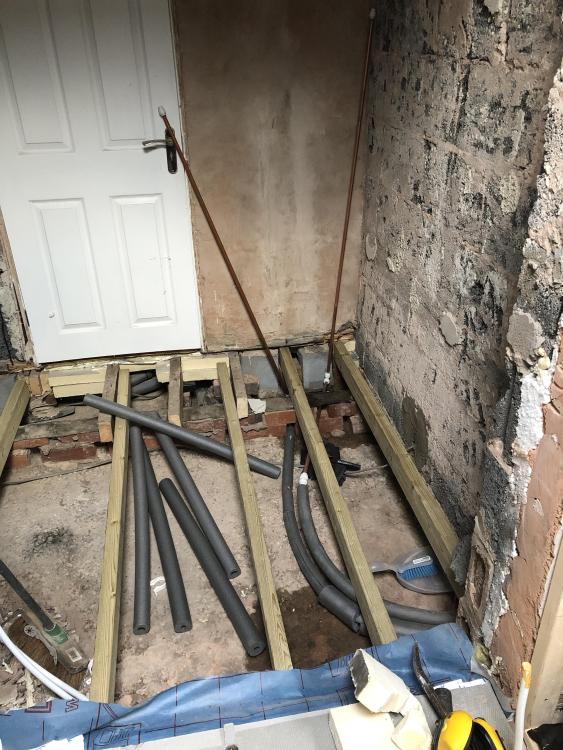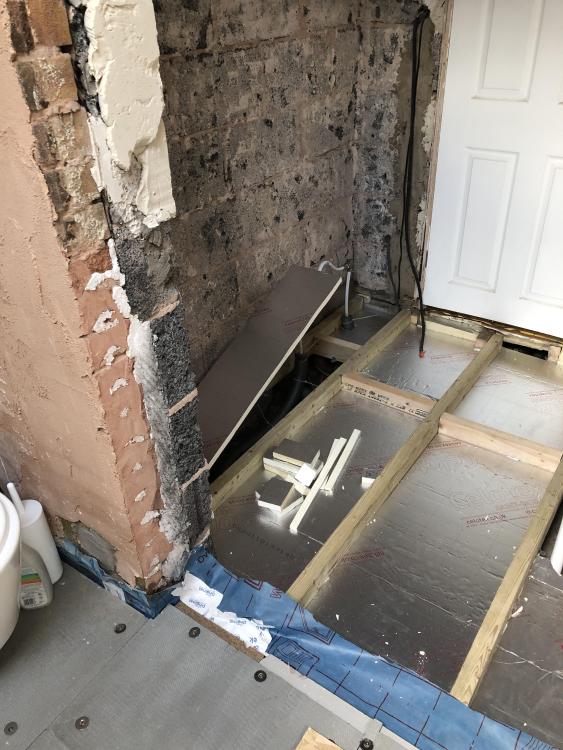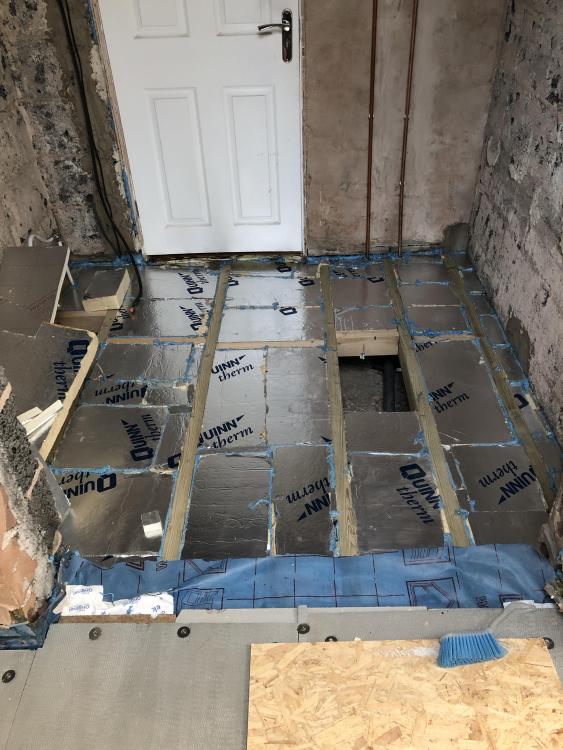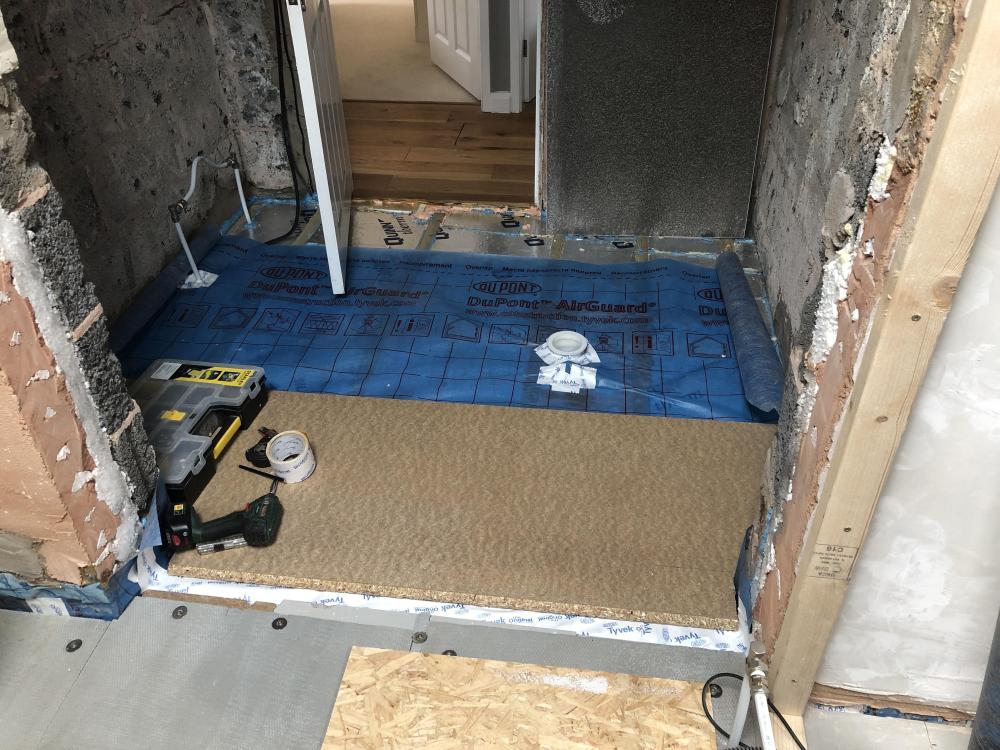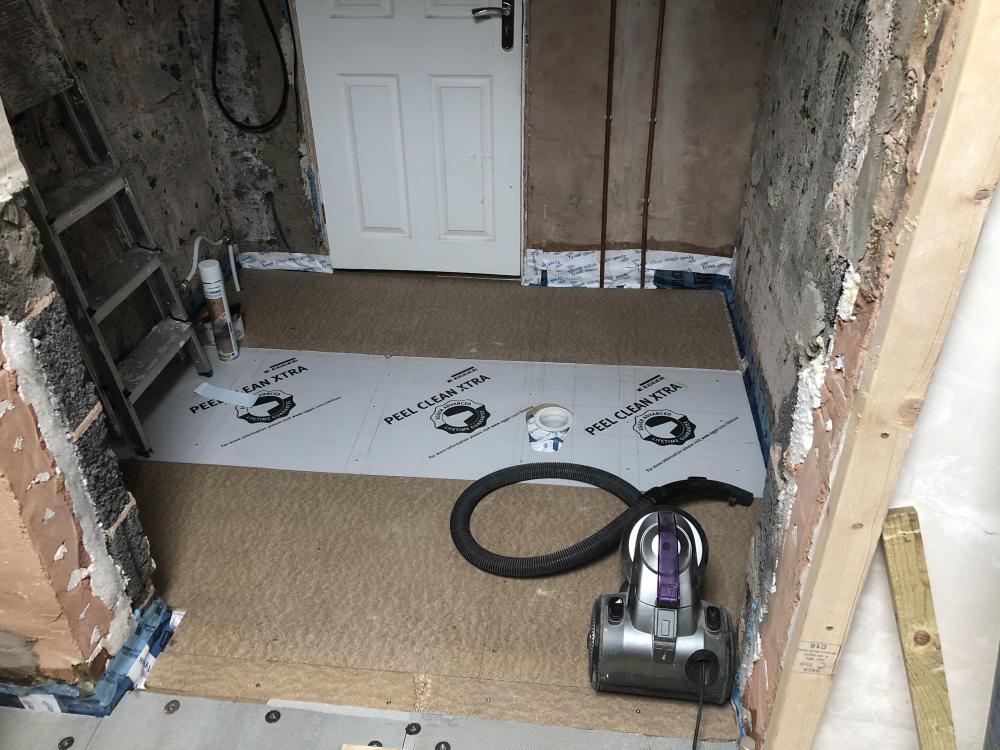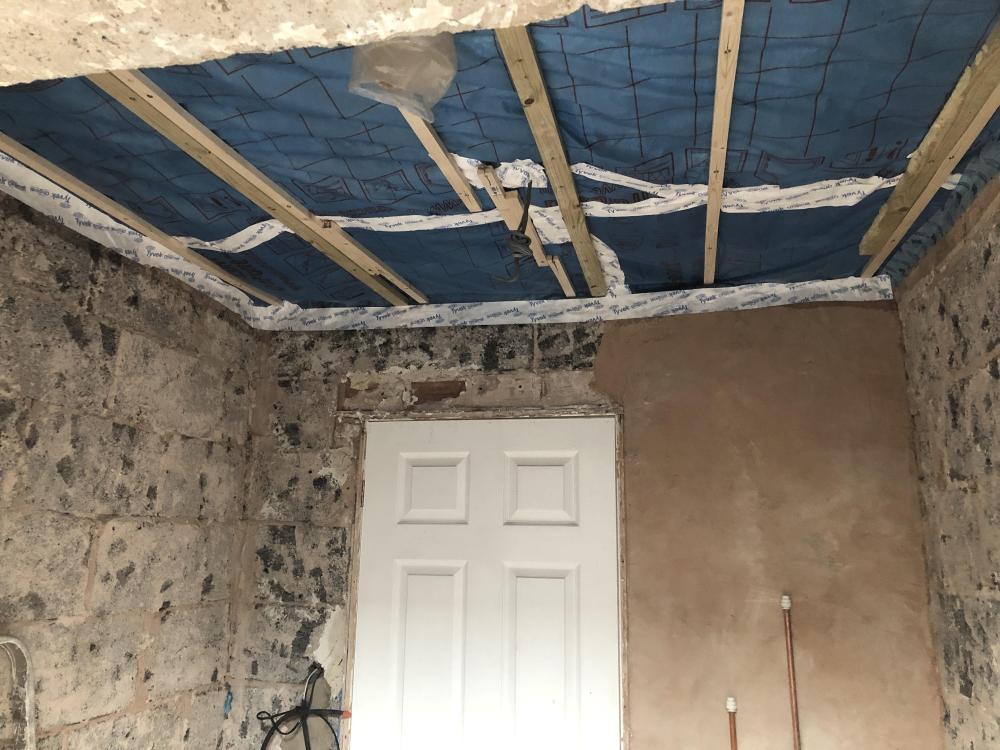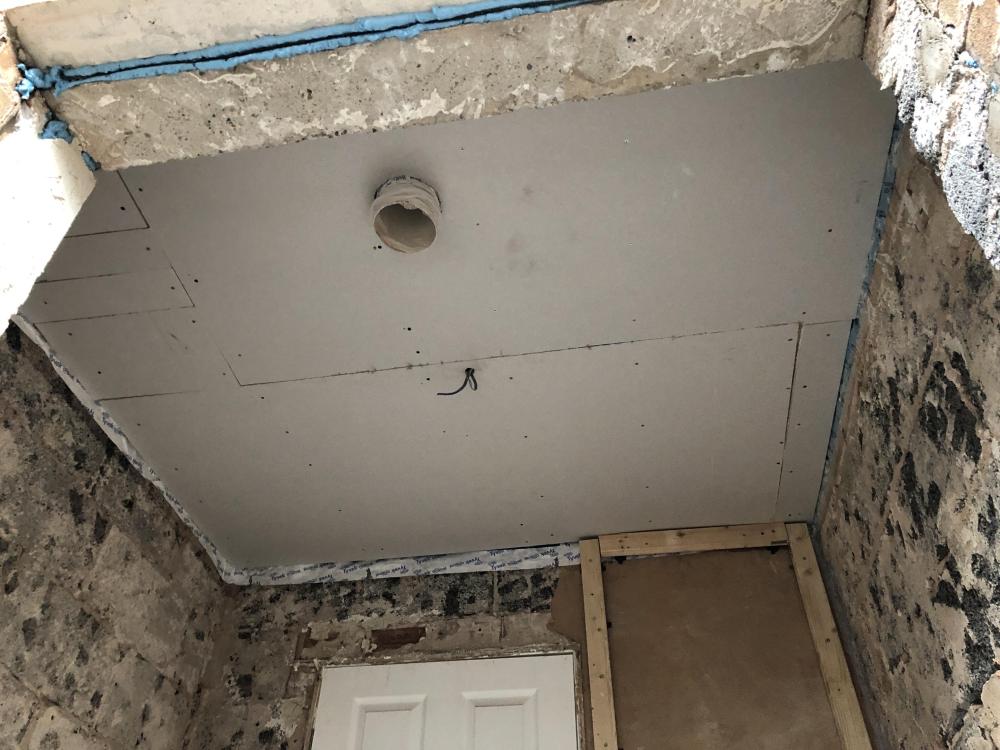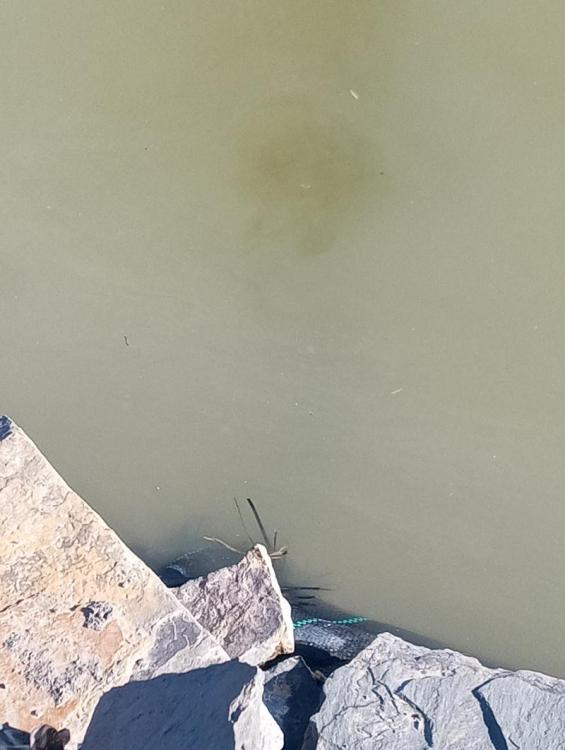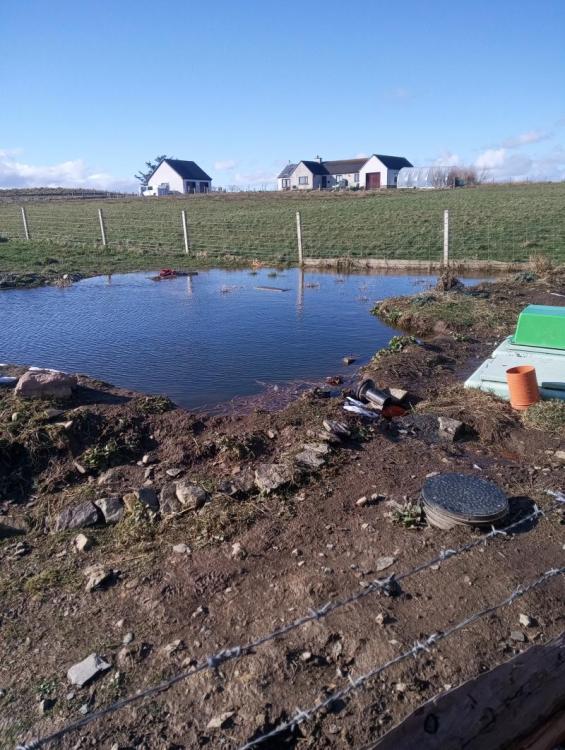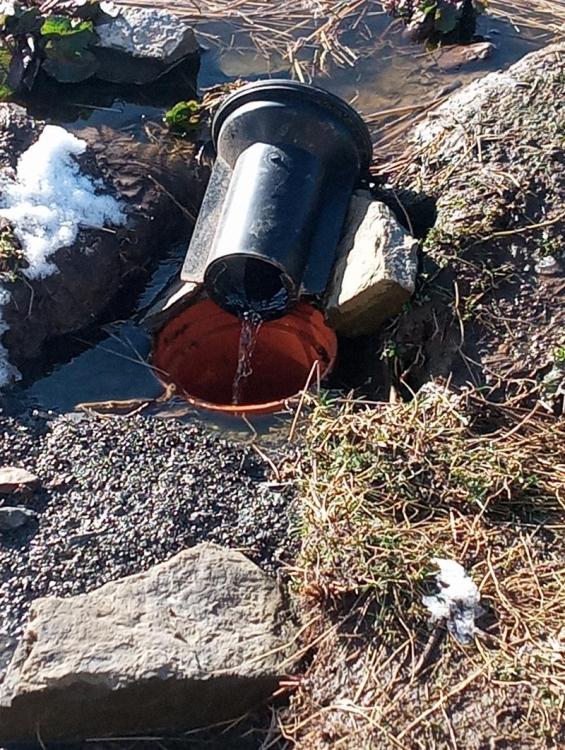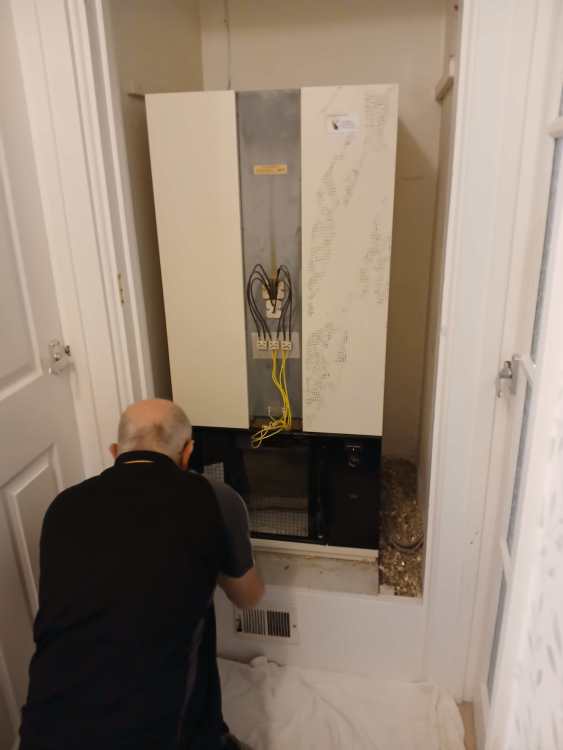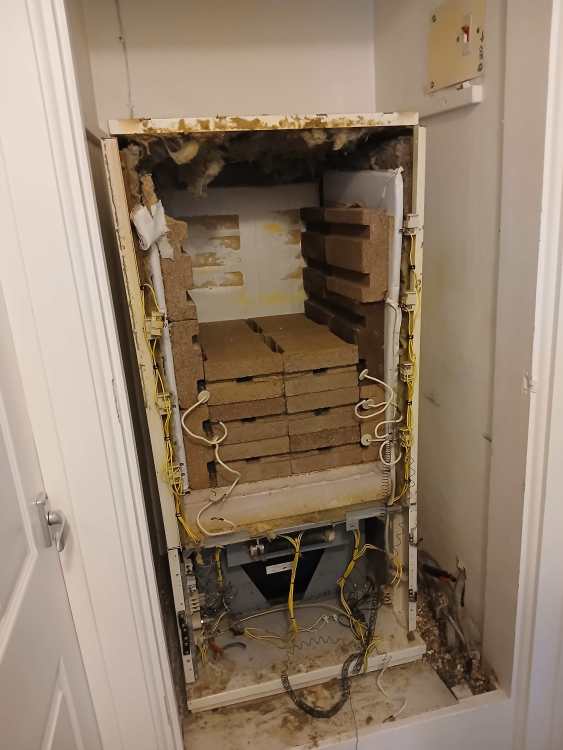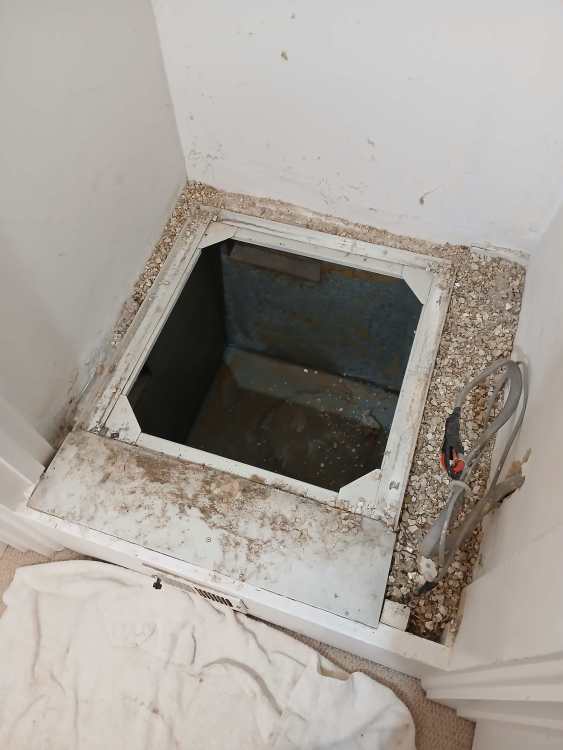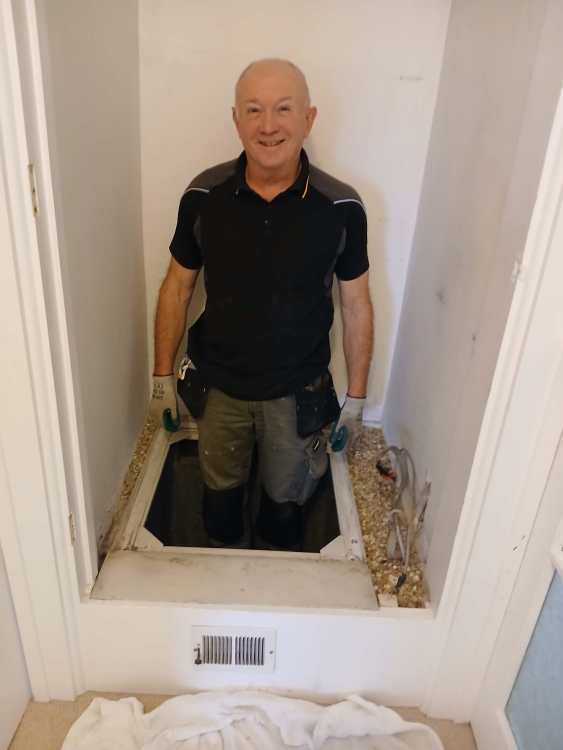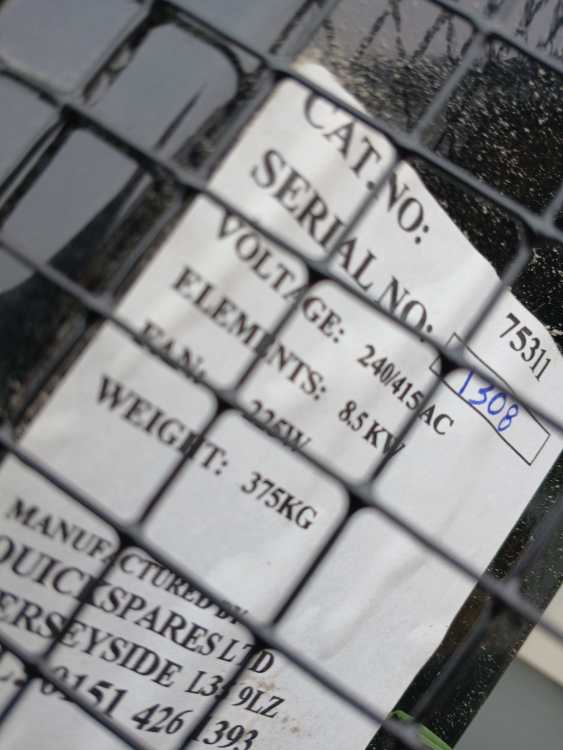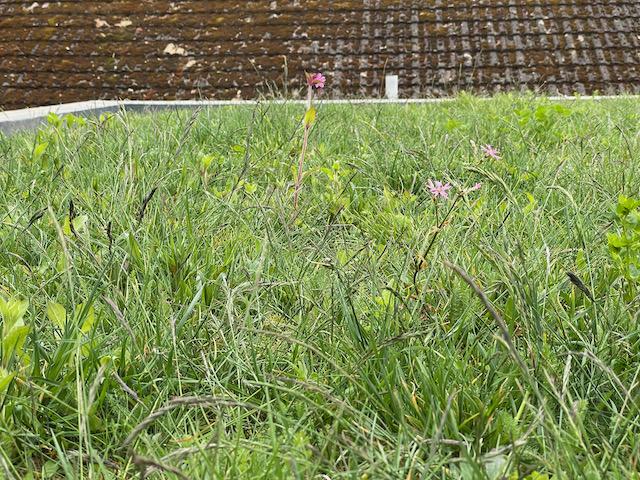Leaderboard
Popular Content
Showing content with the highest reputation since 03/12/24 in Blog Comments
-
7 points
-
An update (after the fact) Plastering finished in the open plan area this coming week (by others) DONE (see above) Remainder of stone cladding arrives and work begins to get the most inaccessible (high) parts put up before the scaffold gets taken away - this means cladding two 7m x 2m wide walls. It arrived and I did get the stonework done on the high parts Plumbing pipework ready for ASHP installation DONE Gabion basket and pad for ASHP to be installed on DONE Mist coat and first coat on plaster (SWMBO is at the ready) DONE Begin fitting upstairs UFH (Not done) Front door being fitted (January) by others DONE Take 3-4 days off for Xmas DONE and appreciated ASHP installation (January) by others, that will allow for hot water and the downstairs UFH to be available ... DONE Fit a temporary bathroom ... DONE Fit out utility room as temp kitchen ...DONE Its been a comfortable month in the house (in fact we are staying an extra few days while it is cold overnight!). We fitted an over bath shower, and done a lot of other work since. and that'll be part of the next blog entry.3 points
-
@Marvin I think I have just about done all the reduction measures I can (except baths). I intend to add a bit more insulation here and there, but it will only make a marginal difference. An EV would make the biggest difference, but at the moment it would not be practical (or affordable) for me. I could get a lodger again, which would pay for an EV, but I like living in my own.3 points
-
I know 3/10 poor rant - needed more variety in the expletives Sorry I'll try to do better next time!!2 points
-
The Commissioning chap came round yesterday, checked the system and listened to our tales of woe. He said that the flow temperature was 10oC lower than recommended and the water temp was only at 44oc when it was specified at 50oC. But apart from that, all was okay. After some tweaks to correct the temperatures, he left. The house is warm enough and Dad seemed to listen to his advice re maintaining a fairly constant temperature, rather than trying to turn off things then expecting them to warm up when turned back on. (Even though I had explained the same several times before - but then I'm just his daughter! What would I know........) So we spent £7k, plus a £7.5k grant from the Government, and from start to finish it took from 11th November till 3rd December to install and make it all work satisfactorily. Not really the best advertisment for ASHP's but if it keeps the old folks warm enough and saves some money from the old system, then I'm happy.2 points
-
2 points
-
2 points
-
Easy peasy. now just think if you had your own machine how much would you have saved. 😉 go and tell the wife.2 points
-
Swear I’m getting slower at this DIY lark! been a very turbulent month and a bit, about a week after I last posted in this thread my dad passed away, and with funeral and starting to sort the mass of stuff in his house, the days have zipped by at a rate of knots. coinciding with what I always find the most difficult part of these jobs, getting the floor structure down, balancing definitely isn’t a strong point! cut out the last of the woodwormed joists and decided to replace everything under there again even though quite a few were new from around 10 years ago, it was the first room I’d done and wasn’t prepared for what I found so the ones I took out were untreated, now replaced with treated. topped up the floor insulation with another 20mm to go with the existing 70mm, new 22mm chipboard, and sorted both heating and supply pipes along with drainage for the shower. be a few weeks now til I get some time to do the first batch of plastering, but I’m just happy it’s starting to look a bit more like a room rather than a building site. Stumbled across a brilliant airtight primer this time too, Tescon's SPrimer, which is a sprayable primer. Saves killing a paintbrush, and is so easy to apply, but its a little smelly for a few days. I've still got a bit of the paint on primer, but don't think i would have had enough to complete the job, managed to get a can off ebay from someone who had finished their works and was selling excess off.2 points
-
After some snow and heavy rain, I can see my design in action, physics doing what physics does. This is the 1st pond that has now overflowed with run off. This level has raised about 400mm. Although not finished. This has now overflowed into a gulley / pipe, that when it's finished will be concreted and form a better overflow outlet. The last pic is the new pond and the darker green shade in the water is the overflow water entering the pond. The new pond rose around 150mm so around 1500l.2 points
-
on that basis I think I’ll treat your future blogg posts as thread resurrections in future1 point
-
Ahh I was honestly wondering when I read the post what percentage of the population would still have concerns along the lines of your blog post - I could absolutely understand your concerns when Pandemic kicked off - fear is a massively powerful weapon and those in power in partnership with the majority of MSM and SM ramped it up to eleventy million percent with no real idea of the consequences of doing that. Lockdown should have never been the answer - we will be paying for it for decades in terms of health and wealth. If anyone is interested (and most probably aren't because they want to put the whole thing behind them) My first trigger point was the "daily death numbers" being announced on the News like it was a tsunami of epic proportions because there was no context - I new the context already 1600 people die per day in England and Wales of natural causes and the News was trumpeting anything from 1 to 100 deaths in a day as "end of the world" stuff - how the feck does the deaths of less than 5% of the normal deaths per day get to be headline news 24/7 A cruise Liner the Diamond Princess gave everyone a a perfect petri dish to illustrate who was at risk. - the results didn't fit with the narative that "those in power" wanted to "spin" so it was dismissed as too small a sample The original pandemic plan got ripped up and thrown in the bin in favour of "the science" which wasn't Science at all BTW Any challenge to the "new science" (like GBD) was labelled "crazy" and "internet was cleansed" to stop the spread, the authors labelled "fringe epidemiologists" Those in authority got "drunk" (in some cases literally) on the new power and did everything they could to keep it whilst themselves broke the "guidance" the set for others How often was a lockdown implemented after the infections had peaked? We were led by a government of muppets and the opposition party instead of doing what they should do which is "hold the muppets to account" and challenging the "rules" introduced instead cried "more more more" My second trigger point was when (having had Covid and recovered) a vaccination against Covid was required for my future well being............. Me "Sorry I need a "vaccine" to stimulate an immune response so I am protected from something I've already had and recovered from - surely that's what post infection immunity has always been about." (Ahh yes it was called "natural immunity" and we can't have that it indicates that people already have immunity and this is a new virus that has escaped from a lab doing US sponsored gain of function on coronavirus's research Sorry of course it was an unfortunate consequence of someone eating bat en croute or Pangolin lasagne Jedi Mind trick "this isn't the lab you are looking for" Third trigger point - The insistence on vaccinating every man, woman and child - Encourage by the Well if you won't volunteer for a vaccine "you really do need" we will restrict your access to travel and entertainment events in order to encourage you to have one The general public banged pans on doorsteps for the NHS who became the National Covid Service (concentrating solely on that and directly shortening the lives of anyone who had routine checks or any other screening process) I lost two friends - not to covid but to missed MRI's or other routine health checks that by the time they restarted the delayed findings were too damn late for them That's before I even think about the initial reaction of hospitals pushing elderly patients back into care homes - like that was a (expletive deleted)ing good idea!!! If you hadn't guessed all of the Covid "over reaction" really really really (expletive deleted)ing boils my piss!!!!!1 point
-
Uh-oh. Having been on an extended quiet period, my blog has gone beserk. This is one of those "push it into the indeterminate future whilst I think about finishing it" posts from about 3 years ago :-). Ooops.1 point
-
That would be really useful data. I often think people are over optimistic about the efficiency they can get from almost every bit of equipment they own. Reducing parasitic loads is an area I really focused on a decade ago, it is why I show two different 'means'. In my larger spreadsheet I can look at the half hourly data and see what is happening.1 point
-
Interesting read - like lots of us on here, I'm always working out ways to reduce our usage and make the most of off peak electricity prices. Like @Marvin we're all electric, with PV, ASHP and in our case batteries not an EV. Now we're in the new year, I'm just working out what we've used this year. At one point in your analysis @SteamyTea, you say a 20% efficiency loss on batteries would be a best guess. This is one thing I was concerned after I'd installed our batteries. What I've noticed is that at low wattage the losses are higher. If this is the case, then there's probably a base loss due to the inverter being 'on' so to speak and then a %age of the actual wattage being delivered. An example from this morning, with a house load of 323W the inverter was actually drawing 397W from the battery, so 19% - which is about your best guess. Later in the morning with the ASHP drawing power, the house load was 2953W and the inverter was using 3187W from the battery (2452) and PV (735W), so about 7%. Unfortunately for all battery users the lowest loads will be the most common and higher loads more intermittent, so losses would be closer to the 20% than the 7%. I'll have to try to dump data from the inverter to get more data points, for example when the batteries are being charged, either from the grid or from the PV etc.1 point
-
Snotgobblers I call them One thing I did like about Covid was it showed the world how good a childs developing immune system was and how it could take on a novel pathogen (CV-19) and just bloody laugh at it like all the other colds and coughs They didn't need vaccinating and there never should have been any attempt to do that all the data screamed that!!!1 point
-
The blue car is a customers Jensen 541 and the grey one is our Jensen FF arriving back from the painters ready for us to complete its restoration.1 point
-
1 point
-
The old mannequin purchased the Jensen Interceptor in September 2011 the car was a rusty wreck that many in the Jensen Owners Club thought was too far gone to restore. In 2014 it won many trophies in the Jensen Owners Club Concours. The old mannequin enjoyed restoring the car so much we bought a Jensen FF. In September 2015 we came on holiday to Cornwall to meet up with other Jensen owners, on the way home we made a five year plan to move down here. The original plan was to find land build a house and a big barn but less than a year later we had found our current home with a big barn. We left our business in Manchester in the hands of his brother and staff who all became small shareholders in the company and started a new business in Cornwall restoring Jensen’s. Our current home has 3 staircases although you could just stay on one level if you chose too, ignoring the 3 extra beds rooms, snug and other rooms. As you can see we’re no spring chickens, the bungalow will be great all on one level for both us and our elderly greyhound. Follow this link https://www.oilyragclassics.co.uk/projects-gallery/jensen-interceptor-mkiii/ for more info on the Jensen Interceptor and for the full restoration blog click here https://joc.org.uk/joc-forum/?w3=dmlld3RvcGljLnBocD9mPTE3JnQ9MTI0NTg=1 point
-
I’m sorry I don’t know cost of the pumps they where part of the builders quote for the foundations. The pumps came from a local quarry about 15 miles maximum, they had at least two like this and it could reach the far side about 20 meters from its parked position. The pump operators were all very good remotely moving the telescopic boom to the correct position.1 point
-
1 point
-
Sometimes life throws the reset switch and gives you the space to re-evaluate and go again; well done for embracing it! Great progress on the house; love the manifold!1 point
-
It will leak air like a Wimpey Home, especially around the doors. When your husband got it, did the old mannequin get left behind.1 point
-
Looking dead good ! Redundancy feels like a kick in the teeth at first . But as you have found out - it can be taken as a positive sign . Onwards and upwards ! 👍1 point
-
I should have known it wasnt going to happen. The Commissioning engineer is now coming next week to give the company time to sort this all out. Which is a good job. The electrician was moved to today (wednesday) as the new Honeywell thermostat was arriving yesterday. However, when i arrived this morning, the electrician was resetting the programme on the old one! He assumed I was not intelligent enough to programme the correct temperatures!🙄 Despite being one of the two who had left it on the factory set schedule, for those out at work all day, not 85yr olds sititng at home all day!! Grrrr! Then i found out, he had not been told about the new thermostat, and questioned why we wanted a wired in version and not wireless😖😩 He left shortly after, saying he'd be back tomorrow with the new thermostat to wire in.........1 point
-
I would set that so it's only 2 degs below normal day time setting, otherwise being a low temperature system, it will take a long time to recover. If it recovers quickly you have the flow temperature set way too high. The way Grant do things from what I read, normal gas engineers install the heat pumps, Grant Corporate Engineer does the commissioning.1 point
-
It all looks lovely and cozy. well done! And thanks for all the details - very useful for our own renovation. 🙂1 point
-
The people who commission the system and sign off everything for the Government grant are coming next week. We have instructions for everything except the Digistat! And the rest of the stuff, we are advised to leave well alone. Apart from adjusting the radiators. I agree with the wireless stuff - far better to have a wired system that we can control - with instructions! I hate Apps and it didnt work from my house so that was a waste of time. I guess there is some way of connecting it to Mums internet so I can control it remotely and I shall have to find out. Today Mum rang and told me that while the house was lovely when they got up, it had turned itself down to 16oC - ie, back to the origonal schedule at 8.30am. Luckily I was able to tell them how to boost the temperature, till I can get there and amend the schedule again. What a nightmare for them 🙁they can do without these programming issues. It is difficult to assess the energy use as it has been on and off since it was installed. We took the old heating system out on the 7th, leaving them with plug in radiators over the weekend. The system was finished on Friday 15th but we need a few weeks to really see if its helping. 16th may have been the day it heated the whole water tank as that is the biggest use.1 point
-
Probably too late now, but at some point this year Johnson & Starley were due to produce a new version of the Aquair 'Heat Interface Unit' to allow a heat pump to supply warm air via the ducts used by those central storage heaters.1 point
-
That will be a big saving in time and money not digging out as much. We have just covered our windows up as well. I hope your enjoying it and not working too hard.1 point
-
We were quoted £400 for removal of the old heating system so we decided to do it ourselves. Thinking it would take all day, it actually came out in a couple of hours. And we even got £10 for the metal at the local recycling place. 😄 Looking at the plate - it was an 8.5KW system - no wonder it used so much electric! There was a large box underneath, with the vents to the other rooms for the warm air. After speaking to the ASHP company, we left the box in place, just tidied up the space. They plan to bring some wood to sit the new system on. After holding up all those bricks, I am sure it will cope with a water cylinder. The plan is to use the bricks in the new garden and make a BBQ with them. they even have grooves for a rack.1 point
-
"How do these figures look" Your PV production is very good for your location. I don't know about 'up there', but our weather has been dreary down here all year.1 point
-
I had similar site inspectors including one half way up the roof looking in the velux rooflights!! Very cheeky of them! Scaffolding is down so they have to content themselves with outside inspections from now on...!! Much colder these days, best of luck with your build too!!1 point
-
Sure, there are a few self build insurance companies depending on your location. This is separate to the mortgage life insurance though as far as I'm aware, at least in my case. I had to shop around quite a bit but google and you'll find a few - they'll need details to apply and see if they will quote / cover you depending on the specifics of your build. Some of the big insurers do this and there are other specialist insurers or you can go through a broker.1 point
-
Second hand is always a gamble, get someone who knows diggers to look over it for you. (I loved every minute of driving my JCB, best boys toy EVER).1 point
-
The first SWMBO here knew about me buying a digger, is when I said "you know that digger on ebay I bid for just before we went out today, well I won it"1 point
-
Great post. These things let folk see what a site looks like, gives them ideas.. food for thought. Well done!1 point
-
Good luck with the purchase, hope it all goes smoothly. you’ll thank yourself for living a stones throw away from your parents, it certainly saves on a lot of stress and time when looking after the oldies, but on the flip side selling their property isn’t quite so nice which I’m in the middle of now with my dads bungalow, still think on balance it’s more a good thing1 point
-
It will be scary if it's not properly restrained against not least movement in the direction of the ridgeline... in fact likely dangerous. John you have a number of pivot points (like rocker bearings) and due to the nature of steel fabrication and behaviour it will tend to buckle sideways due to the vertical load. I can see where you are coming from ( gables taking out the wind load I assume) but it is very important that this arrangement of steel has solid restraint against moving in the direction of the ridge and also perpendicular to the ridge. Please check your SE drawings and make sure you follow them religiously.. don't let the builder / steel fabricator go off and do their own thing. Do this before you load up the roof further. If in doubt get some temporary bracing in.1 point
-
'... How do people in their 60's even do this?!!...' By planning for it. I don't know of one builder over (say) 50 who isn't careful with their upper body. If it's not backs, then it's shoulders or necks. And I'm just about the same as you are: cursing quietly when [...] clicks in. That's what young folk are for - saving our backs. Learn the warning signs, sign off straight away, not '...Oh I'll just [...] ...' For me, it's the single hardest lesson of the build so far. And nobody can see anything except my refusal to get on with it. SWMBO notices the analgesic consumption, but that's about it. Now I look at jobs done in both haste and pain and repent at leisure.1 point
-
1 point
-
Looks great - must be such a relief knowing that the "pour" went without any of the dramas, usually associated with such an option. What do you put that down to - good prep work?1 point
-
@flanagaj 1,800 tiles maybe? Actually it’s all v quick. I’ve only done one but suggest: + 20% of time/effort for membrane/ battens. Yeah, layout carefully but v easy job. Get the laps right on the membrane. + 30% for getting tiles in stacks on the roof. Bit of physical effort. I had a forklift to get them to eaves height. Suggest telehandler / lift is worth it. +30% for laying, v quick and easy, a bit hard on the knees. Nail about 15% especially edges? + 15% for fitting hip / ridge tiles etc. Just a bit fiddly. Cut clean through my angle grinder cable without blowing a fuse. Be more careful than me. + 5% guttering. I was nailing by hand, a nail pouch on a belt is handy.1 point
-
1 point
-
That’s quite a bit of progress despite everything you have gone through. 👍1 point
-
Not sure I would pin myself to passivhaus, but instead follow the principles. A2A you still need a heater for the DHW, so I would stick to a normal ASHP. MVHR several ways to do it, the normal way with a duct and terminal in every room, or cascade, generally duct to each wet room and a couple of supplies only that suit the layout. You will have a demand activated fan through a wall or two for awkward layout rooms that do not lend themselves to being cascaded. An example of said fan https://www.ventilationland.co.uk/en_GB/p/brink-indoor-mixfan-co2-gestuurd-tot-70-m3-h/17927/?gad_source=1&gclid=CjwKCAjwkuqvBhAQEiwA65XxQNHSp3Am0ssSPnBCSOd5avKVIvBbL4-5yDgamc6Up--18SUdWGZUpBoCV34QAvD_BwE Get yourself a thermal camera and see where all the cold bridges are, so you can focus on fixing.1 point
-
Yes, saw in a magazine - it overlooks the internal open plan area and is big enough to act as a perch when you want to read a book and get away from it all!!1 point
-
1 point
-
Thanks. Its funny actually out of all the plots I found, the 4 acre plot was the cheapest (less than a third of others). It was by chance a owned by a previous self builder who built a passivhaus, who sold it to me for the very reason he wanted a self builder to have it, could have went for 3 times the price. A very nice man.1 point
-
This happened to us, we split the land belonging the cottage we had bought, we only lost 5k , we’d paid 250k for cottage and 2acres , we sold 18 months later retaining half the land which we’d got planning on and realised 245k so it doesn’t mean because you’re keeping some of the ground that you’re going to sell the house your in at a big loss. Anyway what I started off going to say here was that we put our plans out to tender with a local company to do the full job, we nearly fell off our chairs when the price came in at £350k , not including oak finishings or staircase and only allowing £8k for a kitchen, tiling only to showers and splash back, the plot had been valued at 125k so there was a total of £475k which the house would never be worth, however we have built the house, we do have an oak staircase and finishings , we have a bespoke kitchen and when we finish off the garden, drive etc we will be in line to have spent around £270k so just over £1k a square metre, it can be done if you’re very careful and we haven’t done a lot of the hard graft just bits and pieces and the drains.1 point


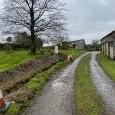


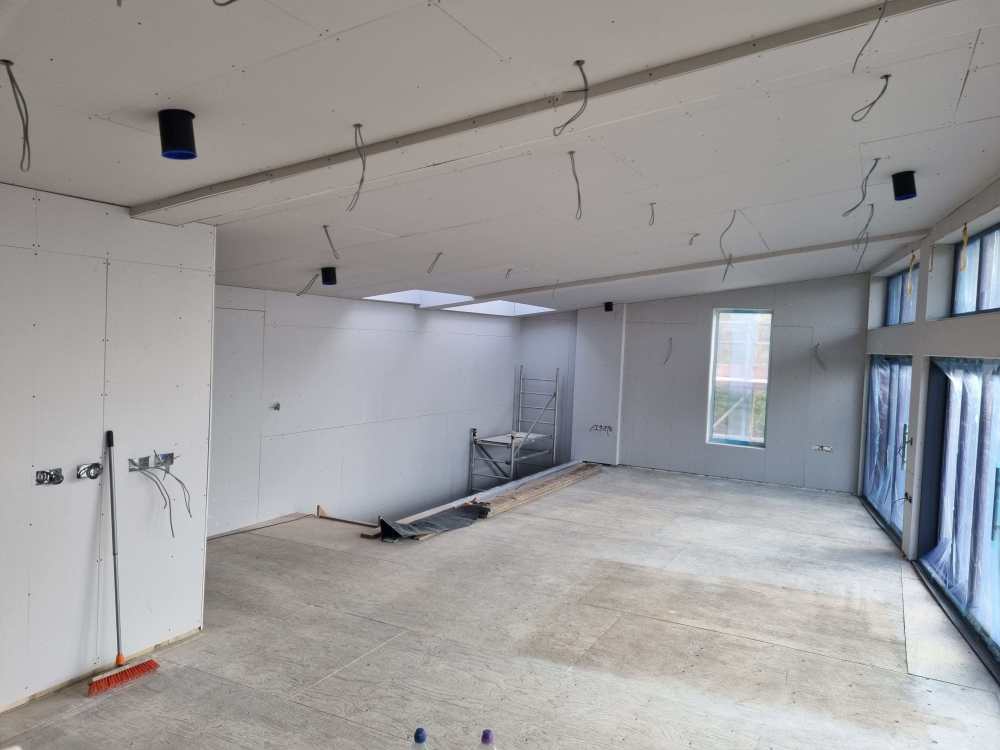
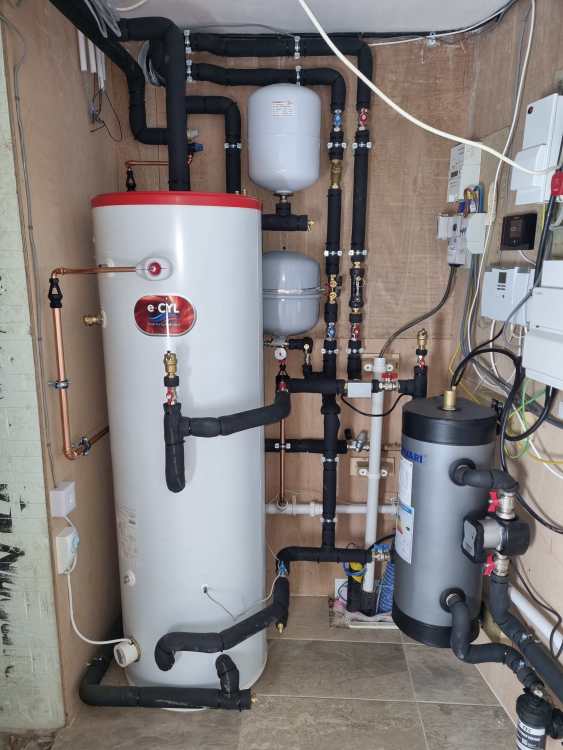
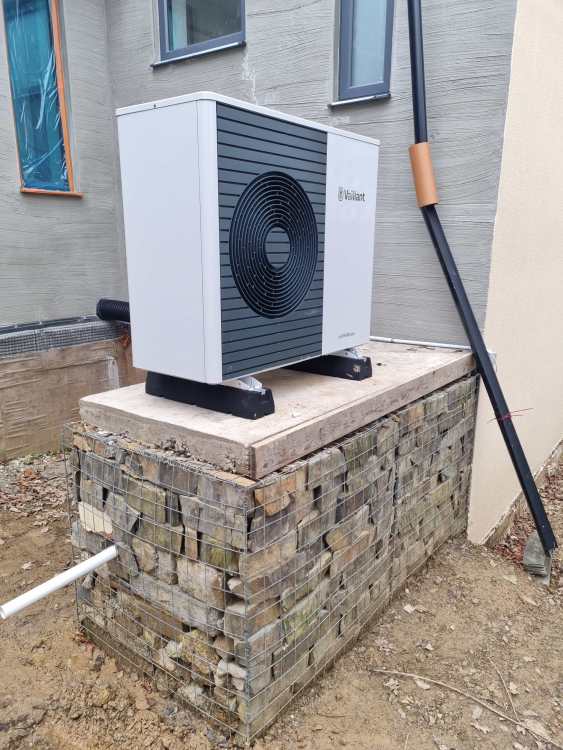
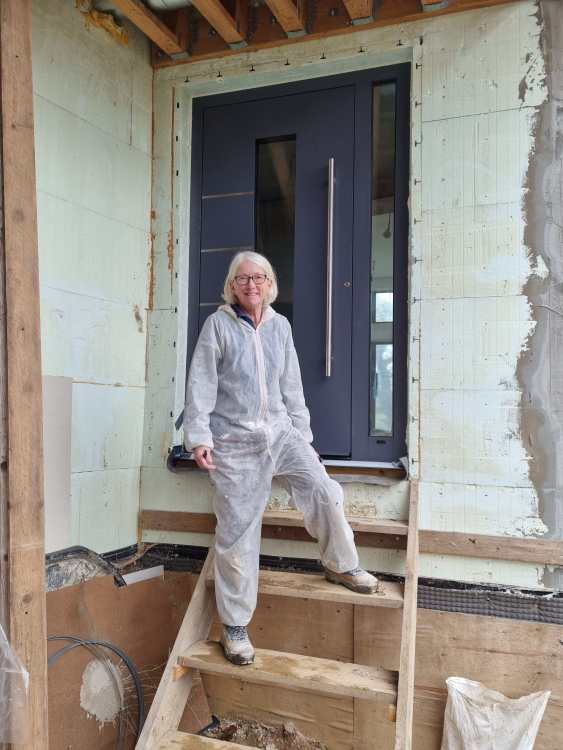
.thumb.jpg.2ae6d8f6692b57b216f5b9376804aa49.jpg)
